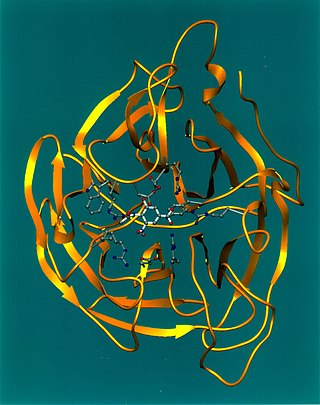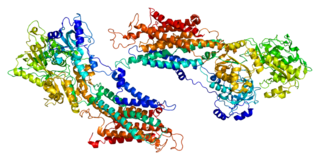
Amitriptyline, sold under the brand name Elavil among others, is a tricyclic antidepressant primarily used to treat major depressive disorder, a variety of pain syndromes such as neuropathic pain, fibromyalgia, migraine and tension headaches. Due to the frequency and prominence of side effects, amitriptyline is generally considered a second-line therapy for these indications.

Exo-α-sialidase is a glycoside hydrolase that cleaves the glycosidic linkages of neuraminic acids:

Orphenadrine is an anticholinergic drug of the ethanolamine antihistamine class; it is closely related to diphenhydramine. It is a muscle relaxant that is used to treat muscle pain and to help with motor control in Parkinson's disease, but has largely been superseded by newer drugs. This substance is considered a dirty drug due to its multiple mechanism of action in different pathways. It was discovered and developed in the 1940s.

Isoprenaline, or isoproterenol, is a medication used for the treatment of bradycardia, heart block, and rarely for asthma. It is a non-selective β adrenoceptor agonist that is the isopropylamine analog of epinephrine (adrenaline).

Etonitazene, also known as EA-4941 or CS-4640, is a benzimidazole opioid, first reported in 1957, that has been shown to have approximately 1,000 to 1,500 times the potency of morphine in animals.

In enzymology, aldose reductase is a cytosolic NADPH-dependent oxidoreductase that catalyzes the reduction of a variety of aldehydes and carbonyls, including monosaccharides. It is primarily known for catalyzing the reduction of glucose to sorbitol, the first step in polyol pathway of glucose metabolism.

Buformin (1-butylbiguanide) is an oral antidiabetic drug of the biguanide class, chemically related to metformin and phenformin. Buformin was marketed by German pharmaceutical company Grünenthal as Silubin.
"Tetrachlorodecaoxide" (TCDO) is a chlorite-containing substance with claimed immunomodulatory, macrophage-activating properties. WF10 (Macrokine, Immunokine, Oxoferin) is an aqueous solution of tetrachlorodecaoxide designed for intravenous injection. Tetrachlorodecaoxide/WF10 were originally developed by Oxo Chemie. The chemical formula is given as Cl4H2O114-. This incomplete formula shows a mixture of chlorite ion, water, and molecular oxygen: "Cl4H2O114-" = 4ClO2− + H2O + O2. Oxoferin was found to be equivalent with aqueous sodium chlorite.

Oripavine is an opioid and the major metabolite of thebaine. It is the parent compound from which a series of semi-synthetic opioids are derived, which includes the compounds etorphine and buprenorphine. Although its analgesic potency is comparable to morphine, it is not used clinically due to its severe toxicity and low therapeutic index. Due to its use in manufacture of strong opioids, oripavine is a controlled substance in some jurisdictions.

Calcium dobesilate is a vasoprotective. It is the calcium salt of dobesilic acid. It is a synthetic molecule with the ability to reduce capillary permeability in the body. In Switzerland the drug is sold by the pharmaceutical company OM Pharma under the trade name of Doxium in capsules containing 500 mg of active ingredient.

Sarcoplasmic/endoplasmic reticulum calcium ATPase 1 (SERCA1) is an enzyme that in humans is encoded by the ATP2A1 gene.

Dilazep is a vasodilator that acts as an adenosine reuptake inhibitor.

Amperozide is an atypical antipsychotic of the diphenylbutylpiperazine class which acts as an antagonist at the 5-HT2A receptor. It does not block dopamine receptors as with most antipsychotic drugs, but does inhibit dopamine release, and alters the firing pattern of dopaminergic neurons. It was investigated for the treatment of schizophrenia in humans, but never adopted clinically. Its main use is instead in veterinary medicine, primarily in intensively farmed pigs, for decreasing aggression and stress and thereby increasing feeding and productivity.

Laser coagulation or laser photocoagulation surgery is used to treat a number of eye diseases and has become widely used in recent decades. During the procedure, a laser is used to finely cauterize ocular blood vessels to attempt to bring about various therapeutic benefits.

Glisoxepide (INN) is an orally available anti-diabetic drug from the group of sulfonylureas. It belongs to second-generation sulfonylureas.

N-Desalkylflurazepam is a benzodiazepine analog and an active metabolite of several other benzodiazepine drugs including flurazepam, flutoprazepam, fludiazepam, midazolam, flutazolam, quazepam, and ethyl loflazepate. It is long-acting, prone to accumulation, and binds unselectively to the various benzodiazepine receptor subtypes. It has been sold as a designer drug from 2016 onward.

Hydroxyprogesterone heptanoate (OHPH), also known as hydroxyprogesterone enanthate (OHPE) and sold under the brand names H.O.P., Lutogil A.P., and Lutogyl A.P. among others, is a progestin medication used for progestogenic indications. It has been formulated both alone and in together with estrogens, androgens/anabolic steroids, and other progestogens in several combination preparations. OHPH is given by injection into muscle at regular intervals.
Nepidermin, also known as recombinant human epidermal growth factor (rhEGF), is a recombinant form of human epidermal growth factor (EGF) and a cicatrizant. As a recombinant form of EGF, nepidermin is an agonist of the epidermal growth factor receptor (EGFR), and is the first EGFR agonist to be marketed. It was developed by Cuban Center for Genetic Engineering and Biotechnology (CIBG), and has been marketed by Heber Biotech as an intralesional injection for diabetic foot ulcer under the trade name Heberprot‐P since 2006. As of 2016, Heberprot‐P had been marketed in 23 countries, but remains unavailable in the United States. In 2015, preparations were made to conduct the Phase III trials required for FDA approval, however as of 2023 developments in U.S.-Cuba relations have stymied importation of the drug from Cuba.
Fritz Scheler was a German internist, nephrologist and university professor. He was a pioneer in the field of hemofiltration treatment and helped found an institute for drug law at the University of Göttingen.

















